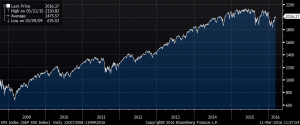On Monday, March 9, 2009, the S&P 500 Index closed at 676.53, representing that index’s lowest close in more than a decade. On the previous Friday, the index touched its low (666.79) in a bear market that seemed like it would continue for some time.
If we think back to that time, we will probably recall how hard it was to be a stock market investor. The financial crisis had hit only a few months earlier. It seemed likely the economy would continue to deteriorate. That Friday morning, the Labor Department reported that the U.S. economy had lost 651,000 jobs in February, continuing the trend of massive job losses that had accelerated in September of 2008 after the credit crisis hit. In fact, 2.6 million Americans lost their jobs in 2008, the highest figure in six decades, and more than two-thirds of the losses came in 2008’s last four months. The majority of us would be hard-pressed to recall a time when the outlook was as bleak as it seemed then. Many investors refrained from opening their brokerage statements, choosing to stuff them unopened in a drawer rather than be reminded of the losses they had suffered.
However, with the benefit of hindsight, we can see that that market was actually presenting us with one of the greatest buying opportunities to come along in decades. In the seven years since, the market has risen at a compound annual growth rate of nearly 48% (about 51% if dividends are included). At the same time, investors needed great courage to overlook the news of the day. Nearly five months earlier Warren Buffett had penned an editorial in the New York Times, “Buy American. I am.” His optimism failed to benefit the market – it fell another 28% before reaching its low. (The chart below shows the performance of the S&P 500 from the close on the Friday before Buffett’s October 16, 2008 editorial was published through mid-day trading on Friday, March 11, 2016.)
As the market started to rally, many investors initially shied away, because they expected the rally to fall apart. After all, the market had moved higher a few times in the previous five months only to reverse course. As has been commonplace for much of the past seven years, many market pundits had little faith in the rally as they felt the market was being supported by the Federal Reserve’s actions. They believed once the Fed turned the printing press off, the market would tumble anew.
The question everyone would like to answer is whether the market is currently transitioning from bull to bear or if we are merely experiencing a correction. Unfortunately, that question cannot be answered with certainty. A quick google search shows that it is pretty easy to find someone forecasting that the worst is yet to come (for example, see: one, two or three).
The pundit in the first link is Albert Edwards, strategist at Société Générale. Not surprisingly, Edwards has been making similar calls for years. In 2010, he called for the S&P to collapse to 450. It didn’t. Investors who took that advice missed out on much of the stock market’s surge since that time – the S&P 500 is up nearly 90%. Of course, we cannot say that Edwards is wrong this time. It is at least possible that his analysis, which maintains that global equity markets are overly dependent on central bank stimulus, will ultimately cause prices to crash when that stimulus is removed.
Unfortunately, Mr. Edwards does not tell investors when this will happen, which makes the analysis much less meaningful. Not surprisingly, this is not unusual. The doom-and-gloom pundits often tell us disaster is coming, but they fail to tell us when it will arrive.
Negative headlines and predictions of market crashes can provide opportunities for long-term investors. Here, it can be instructive to recall one of Mr. Buffett’s well-known quotes: “I will tell you the secret to getting rich on Wall Street. You try to be greedy when others are fearful. And you try to be fearful when others are greedy.”
Turning back to this year’s market recent performance, we see some positive signs. The S&P 500 has surpassed the 2,000 level again a few times in the past week. While it is still down year-to-date, roughly 55% of the stocks in the index are up so far in 2016. This is in contrast to 2015 when about 55% of the stocks in the index fell. Defensive sectors including Consumer Staples, Utilities and Telecom have also touched 52-week highs.
Against this backdrop, we continue to seek opportunities in well-managed, financially solid companies with strong market positions that we believe have become more attractively valued during this period of market weakness.



